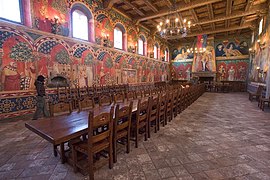Castello di Amorosa
| Castello di Amorosa | |
|---|---|
| Location | Calistoga, California, USA |
| Coordinates | 38°33′30″N 122°32′34″W / 38.5584°N 122.5427°W |
| Appellation | Napa Valley |
| Founded | 2007 |
| First vintage | 2001 |
| Key people | Dario Sattui |
| Cases/yr | 16,000[1] |
| Known for | Il Barone Reserve Cabernet Sauvignon |
| Varietals | Cabernet Sauvignon, Sangiovese, Pinot Noir, Chardonnay, Gewürztraminer, Pinot grigio, Pinot bianco, Muscato, Gioia- Rosato di Sangiovese, Merlot, Barbera, La Fantasia |
| Tasting | Open to the public |
| Website | castellodiamorosa |
Castello di Amorosa is a winery located near Calistoga, California. The winery opened to the public in April 2007, as the project of a fourth-generation vintner, Dario Sattui, who also owns and operates the V. Sattui Winery named after his great-grandfather, Vittorio Sattui, who originally established a winery in San Francisco in 1885 after emigrating from Italy to California.[2][3]
The winery property was once part of an estate owned by Edward Turner Bale.[4] In 1993, Sattui purchased 171 acres (69 ha) for $3.2 million, then spent another $40 million to construct the castle, outbuildings, and the winery inside the castle; construction work began in 1995.[5]
During the Glass Fire that began on September 27, 2020, the farmhouse suffered major damage,[6] the entire 2020 vintage of the wine Fantasia was lost,[7] but the castle was left unharmed.[8]
Inspiration
After graduating with an MBA from the University of California, Berkeley in 1969, Dario Sattui spent two years traveling in Europe, during which time he developed an interest in medieval architecture. He took photos and made sketches of various buildings he would visit including medieval castles, monasteries, palaces, farmhouses and wineries.[9]
Castle

The castle interiors, which include 107 rooms on 8 levels above and below ground, were approximately 121,000 square feet (11,200 m2) when opened in 2007; it has since been expanded to 141,000 square feet (13,100 m2).[5]
Key details and building techniques are architecturally faithful to the 12th and 13th century time period.[10] Among many other features, it includes a moat; a drawbridge, defensive towers, an interior courtyard, a torture chamber, a chapel/church, a knights' chamber, and a 72–30 feet (21.9–9.1 m) great hall with a 22-foot (6.7 m)-high coffered ceiling.
The torture chamber has an iron maiden said to be from the late Renaissance,[11] which Sattui states he bought for $13,000 in Pienza, Italy; a replica rack; and other torture devices.[1][12] The great hall features frescoes painted by two Italian artists, who took about a year and a half to complete, and showcases a 500-year-old fireplace.
The masonry, ironwork, and woodwork were fashioned by hand using old world crafting techniques. Building materials included 8,000 tons of locally quarried stone, paving stones, terra cotta roofing tiles, and 850,000 bricks imported from Europe.[1][13][14] Extending into the hillside adjacent to the castle is a labyrinth of caves some 900 feet (270 m) in length. Beneath the castle are a 2-acre (8,100 m2) barrel cellar and tasting rooms where visitors can sample the wines, all sold only at the Castle or through the winery's wine club.
Due to Napa County restrictions, the castle and grounds cannot be rented for weddings or receptions, but are available to rent for corporate gatherings and fund raisers. In May 2012 the county ordered the winery to cease holding a weekly Catholic Mass in the chapel located on the grounds due to lack of use permits.[15]
-
The castle as seen from the driveway
-
The drawbridge entrance
-
Courtyard
-
The great hall
-
Knights' chambers
-
The wine cellar
-
Exterior walls
-
Torture chamber
References
- ^ a b c Locke, Michelle (August 26, 2007). "California vintner builds wine castle on hill". The Oklahoman. Archived from the original on October 12, 2020. Retrieved October 12, 2020.
- ^ Nolte, Carl (March 28, 2010). "V. Sattui's humble beginnings in North Beach". San Francisco Chronicle. San Francisco, CA. Retrieved April 12, 2010.
- ^ Davis, Kip (September 24, 2010). "Reviving a century-old dream". Napa Valley Register. Napa, CA: Lee Enterprises, Inc. Retrieved September 25, 2010.
- ^ Indardonato, John (January 29, 2004). "Sattui castle combines art, wine and the old world". Napa Valley Register. Napa, CA: Lee Enterprises. Retrieved November 1, 2010.
- ^ a b McLaughlin, Katy (September 19, 2013). "Dario Sattui Built a Castle to House His California Winery". Wall Street Journal. ISSN 0099-9660. Retrieved August 18, 2019.
- ^ Glass Fire turns 120 thousand bottles of wine to ash at a Napa winery. KGTV (Newscast). September 29, 2020. Event occurs at 1:03. Archived from the original on December 12, 2021. Retrieved October 12, 2020.
- ^ Hernandez, Jodi (September 28, 2020). Flames Damage Napa Valley's Famed Castle Winery Castello di Amarosa. KNTV (Newscast). Event occurs at 0:01. Archived from the original on December 12, 2021. Retrieved October 12, 2020.
- ^ Zavoral, Linda; Angst, Maggie (September 30, 2020). "Glass Fire: Napa Valley's Castello di Amorosa winery loses $5 million worth of wine — but $30 million castle unscathed". The Mercury News. Retrieved October 12, 2020.
- ^ "Bios: Dario Sattui". March 30, 2019. Retrieved August 20, 2019.
- ^ Dowd, Katie (September 28, 2020). "Napa Valley's famed castle, Castello di Amorosa, loses building containing all of its bottled wine". SFGate. Archived from the original on September 29, 2020. Retrieved September 29, 2020.
- ^ "History Archives". Castello di Amorosa. Retrieved August 18, 2019.
- ^ Engle, Jane (February 27, 2007). "Napa Valley medieval: Sattui's Castello di Amorosa". Los Angeles Times. Napa, CA. Retrieved April 12, 2010.
- ^ Peter Jensen (July 13, 2013). "Mining Napa's eastern hills". Napa Valley Register. Napa Valley Publishing.
- ^ "Castello di Amorosa". The Press Democrat. September 12, 2007. Archived from the original on October 7, 2007. Retrieved October 12, 2020.
- ^ Scully, Shane (May 23, 2012). "County orders Sattui's 'Castle' to stop church services". The Weekly Calistogan. Calistoga, CA: Lee Enterprises. Retrieved May 29, 2012.








